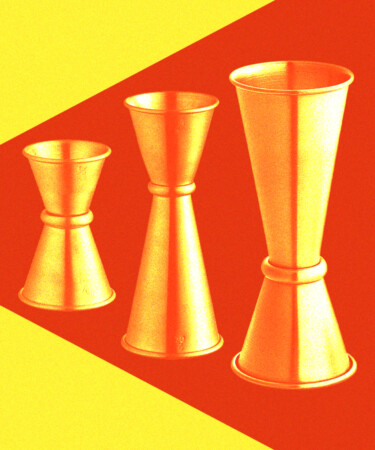There are a few tools of the trade bartenders live by, among them: strainers, bar spoons, and jiggers. Shaped like an hourglass, a jigger is a device used for measuring liquid quantities when making cocktails. A quick glance behind any bar will likely show a few jiggers on hand, varying in size and shape. Although they are all used in the same way, the different sizes can be confusing since most cocktails require roughly the same amount of alcohol.
So what is the reason for the contrasting sizes? To learn more VinePair spoke with bartender and beverage consultant Paula Lukas. A New York City industry veteran and seasoned cocktail competitor, Lukas knows her way around bar tools.
“In a nutshell, bartenders use a jigger for consistency,” she says. Just like chefs need consistency throughout dishes, bartenders need uniformity for cocktails. For this, they depend on the jigger.
Most common among the different variations of jigger is the standard double-sided version that holds 1 and a half ounces on one side and three-quarters of an ounce on the other. For ease and for smaller measurements, most also have fill lines either on the inside or the outside, which range in amounts.
The different styles of jiggers also aid in the dexterity of mixing drinks. The aforementioned standard size follows the American measurement system using amounts that are typical for a shot. British jiggers follow the metric system with measurements given in milliliters instead of ounces.
Another style that is also commonly seen at bars is the Japanese jigger. This variation is larger than the average- sized jigger and has deeper cups on each end. While they are notably a little more streamlined, what makes this style most beneficial is its precision and offering of multiple different measurement amounts.
“Japanese-style jiggers measure 2 ounces on one side, 1 ounce on the other, and often have smaller measurement markings, which is nice when you’re making intricate cocktails,” Lukas says. Their refined narrow shape also makes them easier to pour with.
Many bartenders use both the Japanese and standard styles, often holding both in one hand, to briskly mix drinks that require several components. “Every bartender has their individual preference, but the type of jiggers available also depends on the bar’s beverage program,” she says.
A final, lesser-known style called the bell jigger has a more rounded shape and features a wider mouth. They are not commonly used in bars — likely due to their weightiness — but bell jiggers are an eye-catching piece for home bars and generally have measurements on the outside.
